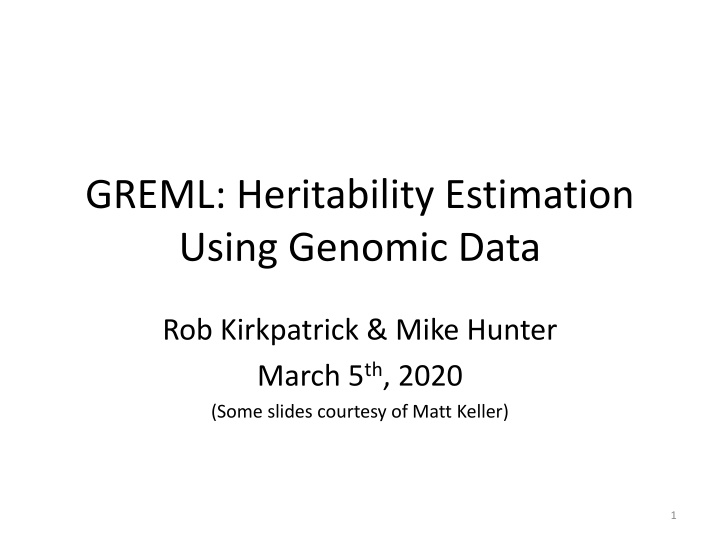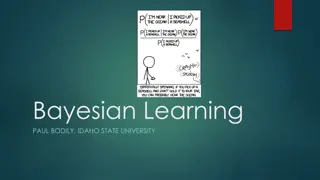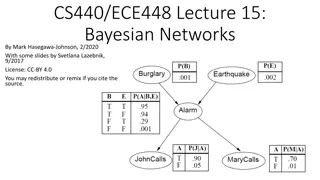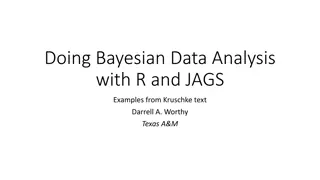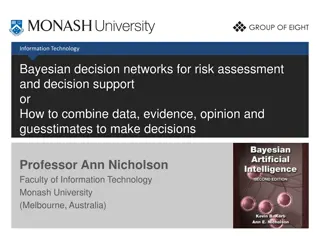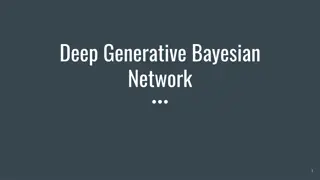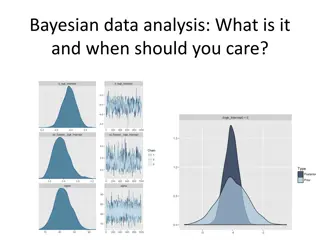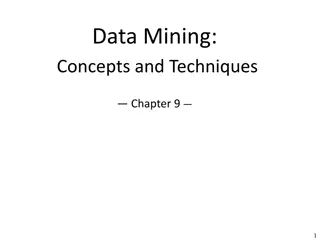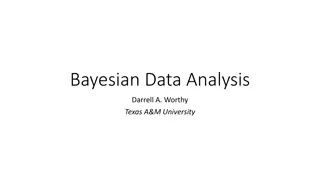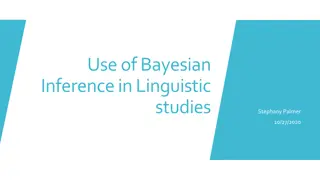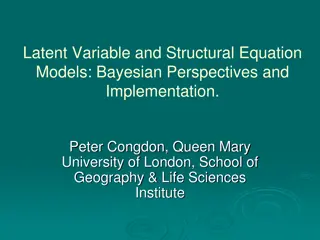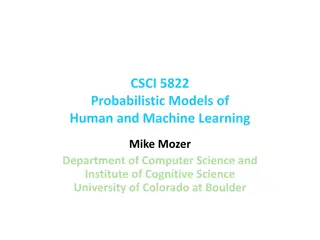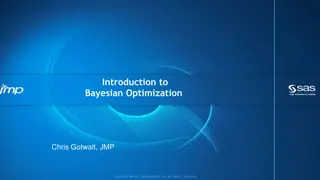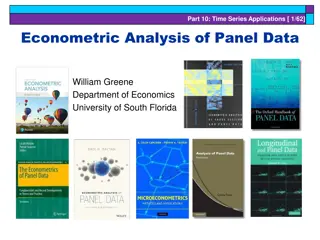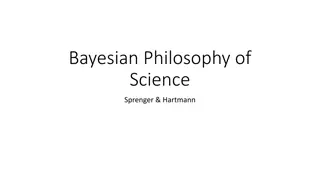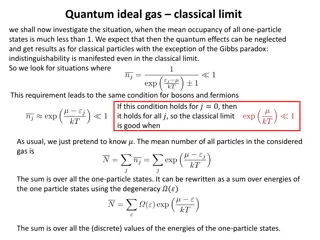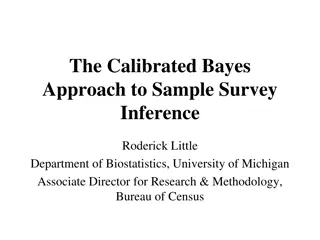Panel Data Econometric Analysis: Bayesian vs. Classical
This study delves into classical and Bayesian approaches in econometric analysis of panel data, focusing on modeling heterogeneity and discrete choice. It contrasts the classical and Bayesian methods, examining mixed logit models, random parameters modeling, and individual taste parameter estimation. References to key literature in classical and Bayesian econometrics are also provided.
Download Presentation

Please find below an Image/Link to download the presentation.
The content on the website is provided AS IS for your information and personal use only. It may not be sold, licensed, or shared on other websites without obtaining consent from the author.If you encounter any issues during the download, it is possible that the publisher has removed the file from their server.
You are allowed to download the files provided on this website for personal or commercial use, subject to the condition that they are used lawfully. All files are the property of their respective owners.
The content on the website is provided AS IS for your information and personal use only. It may not be sold, licensed, or shared on other websites without obtaining consent from the author.
E N D
Presentation Transcript
GREML: Heritability Estimation Using Genomic Data Rob Kirkpatrick & Mike Hunter March 5th, 2020 (Some slides courtesy of Matt Keller) 1
Overview I. II. Genomic Relatedness Matrices. III. GREML. IV. Combining GREML & SEM. V. mxGREML Design. VI. mxGREML Implementation. Regression Estimates of VA. 2
Using genetic similarity at SNPs to estimate VA Determine extent to which genetic similarity at SNPs is related to phenotypic similarity Multiple approaches to derive unbiased estimate of VA captured by measured (common) SNPs Regression (Haseman-Elston) Mixed effects models (GREML) Bayesian (e.g., Bayes-R) LD-score regression 3
Regression estimates of h2 product of centered scores (here, z-scores) (the slope of the regression is an estimate of h2) 4
Regression estimates of h2 (the slope of the regression is an estimate of h2) 5
Regression estimates of h2 COV(MZ) (the slope of the regression is an estimate of h2) 6
Regression estimates of h2 COV(DZ) (the slope of the regression is an estimate of h2) 7
Regression estimates of h2 2*[COV(MZ)-COV(DZ)] = h2 = slope (the slope of the regression is an estimate of h2) 8
Regression estimates of h2 (the slope of the regression is an estimate of h2) 9
Regression estimates of h2 (the slope of the regression is an estimate of h2) 10
Regression estimates of h2snp (the slope of the regression is an estimate of h2) 11
Interpreting h2 estimated from SNPs (h2snp) If close relatives included (e.g., sibs), h2snp h2 estimated from a family-based method, because great influence of extreme pihats. Interpret h2snp as from these designs. If use unrelateds (e.g., pihat < .05): h2snp = proportion of VP due to VA captured by SNPs. Upper bound % VP GWAS can detect Gives idea of the aggregate importance of CVs tagged by SNPs By not using relatives who also share environmental effects: (a) VA estimate 'uncontaminated' by VC & VNA; (b) does not rely on family study assumptions (e.g., r(MZ) > r(DZ) for only genetic reasons) 12
Comparison of approaches for estimating h2snp APPROACH (METHOD) HE-regression Fast. Point estimates usually unbiased ADVANTAGES DISADVANTAGES Large SEs (~30% larger than REML). SE estimates biased. Limited model building. 13
Comparison of approaches for estimating h2snp APPROACH (METHOD) HE-regression Fast. Point estimates usually unbiased ADVANTAGES DISADVANTAGES Large SEs (~30% larger than REML). SE estimates biased. Limited model building. LD-score regression Requires only summary statistics; mostly robust to stratification/relatedness Does not give good estimates of variance due to rare CVs 14
Comparison of approaches for estimating h2snp APPROACH (METHOD) HE-regression Fast. Point estimates usually unbiased ADVANTAGES DISADVANTAGES Large SEs (~30% larger than REML). SE estimates biased. Limited model building. LD-score regression Requires only summary statistics; mostly robust to stratification/relatedness Does not give good estimates of variance due to rare CVs GREML (e.g., GCTA Point estimates & SEs usually unbiased. Well maintained & easy to use Limited model-building (e.g., no nonlinear constraints). 15
However, there will be variance around these expectations. We will use this variance to get leverage on estimating . ??,??? 19
Genomic Relatedness Matrices OpenMx does not compute GRMs from raw genotype data use GCTA, plink, etc. Going from genotypes to GRM can be more complicated correction for possible uneven LD around trait-relevant loci . Possible to use >1 GRM in analysis bin markers by, e.g. Chromosome. Allele frequency. Biological pathway. 20 Speed, D., et al. (2013). AJHG, 91, 1011-1021. doi: 10.1016/j.ajhg.2012.10.010.
III. GREML 21
GREML Model (here, n=3, q=2 fixed effects, m=3 SNPs) ? = ?? + ?? + ? 3 -5 2 1 1 0.8 1 -1.2 * + = 0.4 design matrix of fixed effects (intercept & 1 covariate) observed y fixed effects 22
GREML Model (here, n=3, q=2 fixed effects, m=3 SNPs) ? = ?? + ?? + ? n m 1.15 2.10 -.68 -.58 -.23 .03 1.15 -.23 .03 3 -5 2 1 1 0.8 1 -1.2 * * + + = 0.4 design matrix for SNP effects = design matrix of fixed effects (intercept & 1 covariate) observed y fixed effects SNP effects 23
GREML Model (here, n=3, q=2 fixed effects, m=3 SNPs) ? = ?? + ?? + ? n m 1.15 2.10 -.68 -.58 -.23 .03 1.15 -.23 .03 3 -5 2 1 1 0.8 1 -1.2 * * + + = 0.4 design matrix for SNP effects = design matrix of fixed effects (intercept & 1 covariate) observed y fixed effects residuals SNP effects 24
GREML Model (after removing fixed effects on y) ? ?? = ?? + ? 1.15 2.10 -.68 -.58 -.23 .03 1.15 -.23 .03 -.64 -2.58 3.21 * = + design matrix for SNP effects = residuals y residuals SNP effect s 25
GREML Model (after removing fixed effects on y) ? ?? = ?? + ? 1.15 2.10 -.68 -.58 -.23 .03 1.15 -.23 .03 -.64 -2.58 3.21 * = + design matrix for SNP effects = residuals y residuals SNP effect s We aren t interested in estimating each uibecause m >> n usually, and because such individual estimates would be unreliable. Instead, estimate the variance of ui. 26
GREML Model (after removing fixed effects on y) ? ?? = ?? + ? 1.15 2.10 -.68 -.58 -.23 .03 1.15 -.23 .03 -.64 -2.58 3.21 * = + design matrix for SNP effects = residuals y residuals SNP effect s We assume and therefore 27
GREML Model (we treat u as random and estimate and thus ) var ? | ? = ????? = ????? = ??? 2+ ???2 2/? + ???2 2+ ???2 .41 1.65 -2.05 1.65 6.66 -8.28 -2.05 -8.28 10.3 1 0 1 0 0 0 1 0 0 1.02 -.01 -.02 -.01 1.00 .02 -.02 .02 .98 2 = ??2 + ?? Genomic Relationship Matrix (GRM) at measured SNPs. Each element = observed n-by-n var/covar matrix of residuals y Identity matrix 28
GREML Model (we treat u as random and estimate and thus ) var ? | ? = ????? = ????? = ??? 2+ ???2 2/? + ???2 2+ ???2 .41 1.65 -2.05 1.65 6.66 -8.28 -2.05 -8.28 10.3 1 0 1 0 0 0 1 0 0 1.02 -.01 -.02 -.01 1.00 .02 -.02 .02 .98 2 = ??2 + ?? observed var/covar REML find values of & that maximizes the likelihood of the observed data. Intuitively, this makes the observed and implied var-covar matrices be as similar as possible. implied var/covar 2??2 ?? 29
Individual QC Remove individuals missing > ~.02 Remove close relatives (e.g., --grm-cutoff 0.05) Correlation between pi-hats and shared environment can inflate h2snp estimates Control for stratification (usually 5 or 10 PCs) Different prevalence rates (or ascertainments) between populations can show up as h2snp Control for plates and other technical artifacts Be careful if cases & controls are not randomly placed on plates (can create upward bias in h2snp) 30
Big picture: Using SNPs to estimate h2 Independent approach to estimating h2 Different assumptions than family models. Increasingly tortuous reasoning to suggest traits aren t heritable because methodological flaws When using SNPs with same allele frequency distribution as CVs, provides unbiased estimate of h2 When using common (array) SNPs to estimated relatedness, generally provides downwardly biased estimate of h2 Still missing h2 (h2family h2snp) provides insight into the importance of rare variants, non-additive, or biased h2family. But nota panacea. Biases still exist. Issues need to be worked out (e.g., assortative mating, etc.). 31
GSEM1 R package by Beate St Pourcain (https://gitlab.gwdg.de/beate.stpourcain/gsem ). 1 dedicated function each for fitting CommPthwy, IndePthwy, & Cholesky . Specialized fast & lean. Uses fast BLAS (e.g., ATLAS) for good performance. ML fit. Path-coefficient parameterization. 1St Pourcain et.al. (2018). Biological Psychiatry 83: 598-606 33
mxGREML OpenMx feature. Available in OpenMx since v2.2 (June 2015). Still being developed. 34
Overview of GREML in OpenMx All participants scores on all phenotypes get stacked into a single vector, y. Input dataset is in vanilla wide format--has 1 row per individual: y x [1,] 7.3119 -0.33 [2,] 0.5069 -0.64 [3,] -1.8111 -0.78 [4,] -8.7180 -0.12 [5,] 6.5651 -0.81 [6,] -2.2380 -0.14 36
Overview of GREML in OpenMx All participants scores on all phenotypes get stacked into a single vector, y. Definition variables not allowed/needed. User specifies onto which covariates each phenotype is to be regressed. 37
Overview of GREML in OpenMx All participants scores on all phenotypes get stacked into a single vector, y. Definition variables not allowed/needed. Ordinal phenotypes (incuding binary) must be treated as though continuous. (You correct the h estimate for this fact later.) 38
Overview of GREML in OpenMx All participants scores on all phenotypes get stacked into a single vector, y. Definition variables not allowed/needed. Ordinal phenotypes (incuding binary) must be treated as though continuous. User must specify model for y. Mean of y conditioned on covariates, which are columns of matrix X. var(y | X) is covariance matrix, V, which user must define. 39
GREML: New, Big Idea In previous analyses we ve done so far in OpenMx, the unit of analysis was the family (e.g., twin pair). But if we can use DNA to determine the weak genetic resemblance among classically unrelated individuals, we can treat the entire sample as one large, extended family . Thus, in GREML, the whole sample is one case, and the sole unit of analysis. 40
GREML in OpenMx: assumptions 1. Conditional on covariates X, phenotype vector y is a single drawfrom a multivariate- normal distribution having (in general) dense covariance matrix, V. 2. Random effects are normally distributed. 3. GLS regression (using V-1) is adequate model for phenotypic mean. 41
Overview of mxGREML Feature 0. Condensed matrix slots. 1. GREML expectation & (incl. automated data- structuring). 2. GREML fitfunction. 43
Large Matrices and Memory Efficiency Demo script Main idea when your OpenMx script involves large matrices that contain no free parameters: 1. Place options(mxCondenseMatrixSlots=TRUE) near beginning of script. 2. Always access slots of MxMatrix objects with $, and never with @. 44
GREML Expectation Compatible with GREML fitfunction and ML fitfunction (but ). In OpenMx terms, requires raw continuous data... But, strictly speaking, does not require raw genotypic or phenotypic data--at minimum, you need: 1 or more GRMs. Phenotype scores with covariates partialled out. 45
GREML Expectation Compatible with GREML fitfunction and ML fitfunction (but ). In OpenMx terms, requires raw continuous data. User tells it: Which algebra/matrix is V. Arguments for data-structuring. Whether & how to resize V at runtime due to missing data. 46
Imagine we have 3 participants and 3 phenotypes, and were using the same covariate, x, for all 3 phenotypes blockByPheno=TRUE, staggerZeroes=TRUE 1 0 0 0 0 x ALC 1 1 1 0 0 0 0 x ALC 2 2 1 0 0 x 0 0 x ALC 3 3 0 0 1 0 0 CAN 1 1 = = y X CAN 0 0 1 0 0 x 2 2 CAN 0 0 1 0 0 x x 3 3 NIC 0 0 0 0 1 1 1 NIC 0 0 0 0 1 x 2 2 NIC 0 0 0 0 1 x 3 3 47
GREML fitfunction Support for analytic derivatives (which we will not do). Otherwise, use SLSQP, which can calculate numeric fitfunction derivatives in parallel. 48
mxGREML Practical In the interest of time, we will fit a very simple monophenotype AE model See also: https://github.com/RMKirkpatrick/mxGREMLd emos . 49
Miscellaneousstuff we didnt cover Be careful using GREML with any kind of ascertained sample. Use of >1 GRM (or other such relatedness matrix ). Computational shortcuts available for simple models (e.g., diagonalization). Technical aspects of computing GRMs. 50
